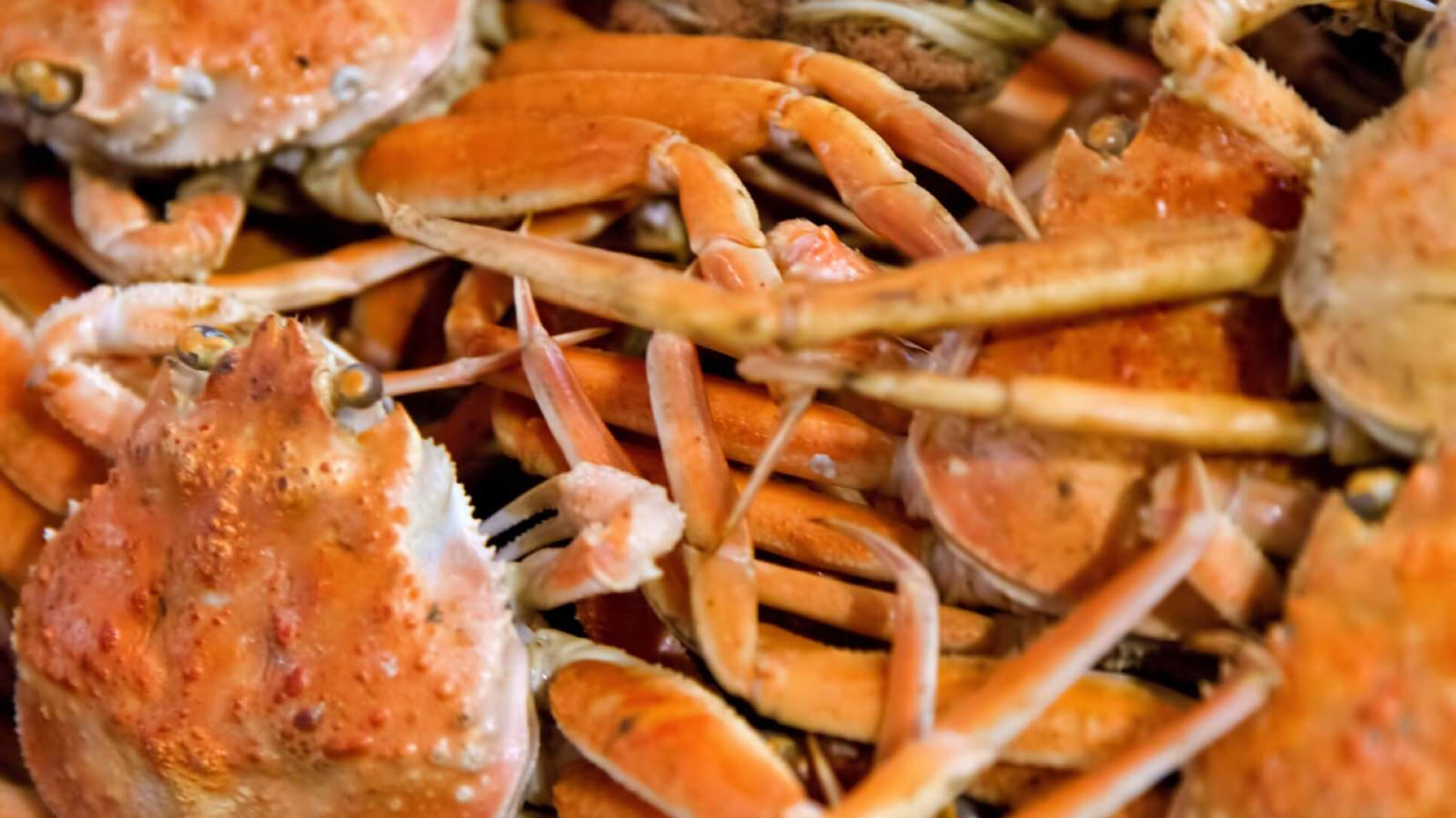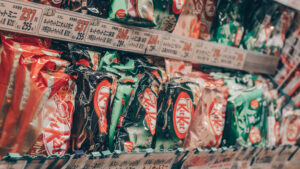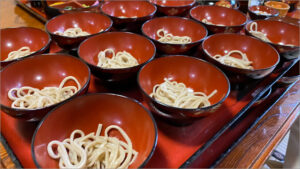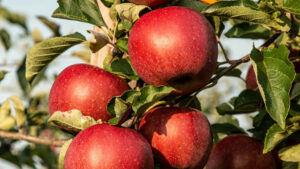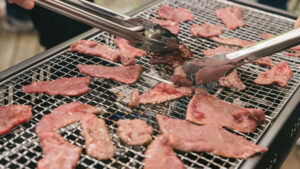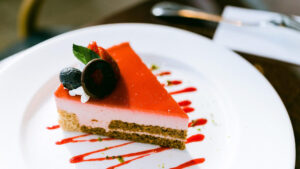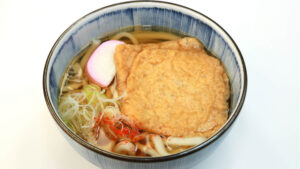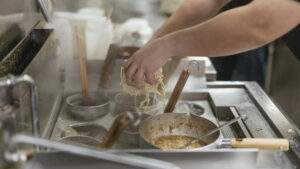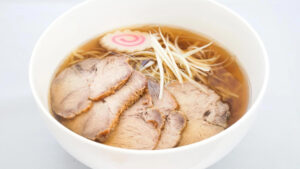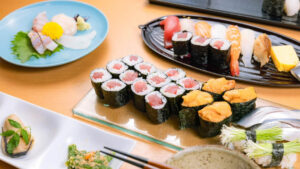Hokkaido, blessed by both the ocean and the land, is a food theme park—from seafood like crab, sea urchin (uni), salmon roe (ikura), and scallops to jingisukan (grilled lamb), soup curry, and butadon (pork rice bowl), finishing with shime parfaits, cheesecake, and classic local sweets.
To help you find the most delicious bite
for your travel season and destination, this article summarizes seasonal windows and regional trends.
Seafood at the morning markets, the bounty of the land for lunch, and sweets to close out the night— use this as your one-day Hokkaido gourmet plan.
Contents
Enjoy Hokkaido’s Bounty from the Sea
Crab Feast (Kegani • Taraba • Zuwai)
Hokkaido is a true “crab paradise.” Because harvest seasons overlap across the region, you can enjoy many varieties throughout the year depending on when you travel. Below are the three stars—plus two connoisseur favorites—so you can match your trip to the best bite.
Tarabagani (King Crab): Features, Season & How to Eat
Known as the “king of crabs,” taraba boasts thick, springy legs and a rich natural sweetness.
Hokkaido lands a large share of Japan’s catch, and Wakkanai Port is known for the nation’s highest landings.
- Fishing season (approx.): Jan–May / Sep–Oct (varies by area). Most available at shops around Apr–Jun and Nov–Feb.
- How to enjoy: Boiled or grilled are classics. In peak season, try sashimi or kani-shabu. High-quality frozen legs are delicious after simple natural thawing.
Kegani (Horsehair Crab): Features, Season & How to Eat
A small crab covered with fine hairs, prized for its dense, flavorful kani miso (crab tomalley) and firm, delicate meat.
- Peak by area (guide): Okhotsk Sea Mar–Jun / Funka Bay Jul–Aug / Eastern Hokkaido Sep–Oct / Erimo Nov–Dec. Somewhere in Hokkaido is almost always in season.
- How to enjoy: Mix meat with kani miso for the “insider” way to eat. Also popular: grilled tomalley in the shell, rice porridge, or warming korazake (hot sake in the shell).
Zuwaigani (Snow Crab—often Red Snow Crab in Hokkaido): Features, Season & How to Eat
In Hokkaido, “zuwai” often refers to beni-zuwai (red snow crab). The flesh is notably juicy and gently sweet.
- Season (guide): Apr–Jun. Catches off Rishiri/Rebun and Esashi are well known.
- How to enjoy: Excellent raw as sashimi for a silky, lightly sweet bite; also great as shabu or tempura.
- Trivia: Hokkaido lands three types—true snow crab, red snow crab, and queen crab. For pure flavor choose true snow crab; for meat volume & value choose red; for tomalley & value choose queen.
Bonus ① Aburagani (Affordable “look-alike”)
Similar in appearance to king crab, with a long season from Jan–Jun.
It’s relatively budget-friendly, and when fresh and locally sourced, it offers excellent sweetness and texture.
- How to enjoy: Boiled is classic, and tempura adds extra volume and satisfaction.
Bonus ② Hanasaki Crab (“phantom crab”)
Landed in small quantities along the Eastern Hokkaido–Cape Erimo–Nemuro coast from Jul–Sep. The short season makes it rare; the meat is said to be even richer than king crab.
- How to enjoy: The signature miso soup teppō-jiru pairs perfectly with kombu dashi, letting the crab’s umami permeate the broth.
Season Calendar (guide)
- Tarabagani (King crab): Apr–Jun / Nov–Feb (most commonly seen in shops)
- Zuwaigani (Snow crab): Nov–Mar (Honshu guide). In Hokkaido, beni-zuwai (red snow crab) is best around Apr–Jun.
- Kegani (Horsehair crab): Year-round (peak rotates by area)
- Hanasaki crab: Jul–Sep
Tip: Before traveling, check the latest information from local markets, fishery co-ops, or famous restaurants at your destination.
Seafood Rice Bowls: Uni, Ikura, Salmon & More
Hokkaido’s seafood bowls bring together the peak flavors of the season in a single serving—featuring uni (sea urchin), ikura (salmon roe), and salmon as the stars.
Below you’ll find the main varieties, seasons, key production areas, and tips for enjoying them on rice.
Types of Uni & Seasons (Bafun • Ezo-bafun • Murasaki • Kita-murasaki)
Hokkaido leads Japan in sea urchin landings. The four principal types are:
- Bafun uni: Small, orange lobes with an intensely rich flavor.
- Ezo-bafun uni: Larger and more vividly colored than bafun; very sweet and rich.
- Murasaki uni: Familiar long, dark spines; refined, clean ocean aroma.
- Kita-murasaki uni: Similar shape to murasaki but larger (shell up to ~10 cm). Pale yellow lobes that
hold their shape, making them popular for sushi.
While each area sets its own closed seasons, uni is harvested somewhere in Hokkaido almost all year.
The peak generally falls June–August, before spawning.
- Jan–Jun: Rausu
- Mar–May: Erimo, Hidaka
- Apr–Jun: Rebun Island, Ōmu
- May–Jul: Otaru, Esashi
- Jun–Aug: Rishiri Island, Rebun Island, Shakotan, Otaru, Iwanai, Teuri Island
- Jul–Aug: Okushiri Island
- Late Sep–Dec: Matsumae (Southern Hokkaido)
Note: The Shakotan Peninsula is especially famous for uni.
Ikura (Salmon Roe): Season, Regions & How to Enjoy
Raised in Hokkaido’s cold seas, ikura shines with its vivid orange color and satisfying pop.
- Season: Sep–Nov (peaks with the salmon run).
- Main regions: Shiretoko, Abashiri, Kushiro.
- Processing: Quickly handled after catch and prepared as
shiozuke (salt-cured) or shōyuzuke (soy-cured) to highlight the natural flavor.
On rice bowls, the classic combo is uni × ikura. Use only a little soy sauce and taste it plain first to enjoy the natural sweetness and aroma.
Salmon Varieties: Seasons & Bowl Tips
Hokkaido is Japan’s top salmon region, and each species has its own prime season and flavor profile:
- Sockeye (Beni-zake): Deep red flesh with rich, concentrated flavor. Jun–Aug.
Great grilled, salted, or as ochazuke. - Autumn Chum (Aki-zake/Shiro-zake): The most common; light and clean. Sep–Nov.
Excellent for fry, meunière, or mixed-rice dishes. - Tokishirazu (“off-season” chum): Runs spring–summer. Apr–Jul.
Notably fatty—superb as sashimi or simply salted and grilled. - Pink (Karafuto-masu): Jul–Aug. Moderate fat; great fried, meunière, or salted and grilled.
For a standout bowl, mix textures and aromas: combine sashimi, a light soy marinade, and a touch of aburi (quick torching) to create a satisfying contrast of fat, fragrance, and freshness.
Butter-Sautéed Scallops & Sashimi
Hokkaido scallops deliver the perfect trio of sweetness, umami, and texture. Knowing how they’re harvested and when they peak makes it easier to choose the best way to enjoy them on your trip.
Two Scallop Fisheries in Hokkaido (Reseeding / Suspension)
- Reseeding (jimaki) method: In the Okhotsk Sea and the Nemuro Strait, juveniles are raised for one year, released to the seabed, then grow in the wild for 2–4 years before harvest.
- Suspension (suika) method: In Funka Bay and the Sea of Japan, juveniles are hung in the water in ropes or baskets and slowly grown for 1–2 years.
Both methods benefit from Hokkaido’s pristine waters, yielding scallops with thick, sweet adductor muscles.
Season & Processing Guide
- Reseeding: Peak landings from early summer to autumn; often processed locally into kaibashira (adductor muscles) and dried scallops.
- Suspension: More landings in winter to spring; commonly shipped as boiled scallops and shucked meats.
Match your travel season to the style: choose sashimi-grade (raw) in peak freshness, or go for cooking-friendly (boiled/shucked) when heat brings out their juiciness.
The Joy of Visiting Production Areas (Hamatonbetsu, Shakotan & more)
Ports like Hamatonbetsu and Shakotan maintain strict water-quality control and blend traditional fishing with modern aquaculture, producing plump, juicy scallops thanks to the region’s cold currents. At local markets and direct-sale spots, you can hear stories from fishers about cultivation and regional history—then taste ultra-fresh scallops to appreciate their delicate sweetness and fine texture.
Enjoy Hokkaido’s Bounty from the Land
Jingisukan (grilled lamb/mutton)
A must-eat when visiting Sapporo, jingisukan is a beloved Hokkaido soul food: relatively low in calories, high in protein, and delicious whether grilled or simmered. Below is a quick guide to its history, how to enjoy it, and tips for ordering.
History & Background
- Taishō era: World War I made wool imports difficult, so Japan encouraged sheep
farming. In Hokkaido, flocks expanded and mutton began appearing on the table. - Post-war: Wool demand surged, then—after imported wool and synthetics spread—Hokkaido
shifted toward meat production breeds. - Origins: There are several theories; one holds it was adapted for Japanese tastes
from the Chinese grilled-lamb dish kǎo yángròu (烤羊肉). - Today it’s known nationwide, selected among Japan’s “One Hundred Local Dishes,” and celebrated as
part of Hokkaido’s culinary heritage.
What It Is
- Meat and vegetables are cooked together on a domed, ridged iron pan designed for jingisukan.
- Meat juices run down the slope to the vegetables, yielding crispy, fragrant meat and
umami-rich veggies. - It’s popular at home too and a staple for spring hanami and summer BBQs.
Two Ways to Enjoy It
- Fresh-cut meat + dipping sauce: Grill the meat plain, then dip in sauce. The classic style that lets you taste lamb’s aroma and umami directly.
- Marinated (pre-seasoned): Meat is soaked in a soy-based special sauce, then grilled. A bolder flavor that pairs perfectly with rice or beer.
Lamb vs. Mutton
- Lamb (under 1 year): Tender with very little gaminess—ideal for first-timers.
- Mutton (2 years or older): Richer fat and deeper flavor for connoisseurs; great with spices and robust sauces.
Vegetables & “Shime” (Finishing)
- Classic veggies: Onion, bean sprouts, bell pepper, cabbage; also eggplant, carrot, and corn to taste.
- Grilling tip: Spread vegetables around the outer ring, grill meat in the center, and let the juices run down to season the veggies.
- Finish (“shime”): Add udon or Chinese-style noodles to the pan juices and leftover sauce to savor every drop of flavor.
Soup Curry
Born in Sapporo, soup curry features a light, spice-fragrant broth paired with large-cut toppings. Base, heat level, and portion vary widely by shop, making it a dish that’s fun to compare.
What Is Soup Curry? (Features)
- Not a roux-based curry—it’s a broth-like soup that delivers spice aroma, tingle, and heat directly.
- Toppings showcase Hokkaido’s produce: chunky jagaimo (potatoes), carrots, kabocha, broccoli, plus
chicken leg, braised pork, or seafood—tender enough to flake with a spoon. - Rice is served on a separate plate; the classic way is to dip spoonfuls of rice into the soup.
Origins & History
In the 1970s, Sapporo café Ajanta introduced its “yakuzen curry” around 1975, which became the prototype. Popularity grew steadily, and by the 2000s it had boomed in Sapporo, settling in as a local soul food and spreading nationwide.
Soup Bases & Flavor Profiles
- Chicken / Vegetable stock: Light-bodied with clearly defined spices.
- Shrimp stock: Toasty shellfish umami front and center.
- Pork or beef bones: Deeper, rounder body with extra richness.
Spice blends vary by restaurant, so you’ll find everything from very thin, clear broths to slightly thicker styles—each with its own character.
How to Choose Heat, Rice & Toppings
- Heat level: Usually a multi-step scale (e.g., 0–10). Higher heat lifts the spice aroma, but for first-timers medium (standard to +1) is a safe pick.
- Rice portion: From small to extra-large. Because the soup is the star, a slightly smaller portion than your usual is often satisfying.
- Toppings: A wide range such as deep-fried vegetables, onsen egg, natto, and cheese. Since many bowls are already loaded, limit extras to about two so the flavors stay focused.
Butadon (Pork Rice Bowl)
Originating in Obihiro, butadon is a Tokachi soul food: thick-cut pork grilled until fragrant in a sweet soy glaze and heaped over hot white rice.
Its simplicity means the magic lies in the grill and the tare (sauce).
History & Origins
- Late Meiji era: Pig farming began in the Tokachi region, making pork a familiar ingredient.
- Early Shōwa (1933): At the Obihiro diner Pancho, founder
Hideshi Abe devised a bowl of charcoal-grilled pork glazed with an
eel-style kabayaki sauce—a stamina dish using readily available pork in place of pricey eel. - It spread from Obihiro and became a nationally known specialty. The city now has many dedicated shops,
and even distributes a local Butadon Map.
When to Eat
- A year-round staple—served at home and at specialty restaurants alike.
- Across Tokachi and Obihiro, it’s commonly available in every season and loved by locals and visitors.
What Makes It Great (Meat, Sauce, Grilling)
- Cuts: Loin (tender, refined) / Belly (sweet, rich fat).
- Sauce: A sweet-savory glaze based on sugar × soy sauce; ratios and intensity vary by shop or household.
- Grilling: Pan or teppan works, but charcoal brings unmatched smokiness.
- Presentation: Kept simple—often just a little shiraga-negi (shredded scallion) or a few green peas on top.
Finish with Sweets & Dairy
Sapporo “Shime Parfait”
The classic way to end a night in Sapporo is with a shime parfait. Originating from the French parfait (“perfect”), this dessert culture has been reimagined in Japan as a late-night treat.
Using Hokkaido milk, seasonal fruits, baked confections, and sometimes a touch of alcohol, it’s the ultimate grown-up reward.
What Is a Shime Parfait?
- A parfait enjoyed as the “shime” (finale) after drinks or dinner.
- Typically served in a tall glass layered with ice cream or soft serve, fruits, fresh cream, sauces, and baked sweets—the Japanese/American-style parfait.
- Often sized and formulated for night: lighter portions and less-sweet profiles.
How It Took Root in Sapporo (Background & History)
- Building on Sapporo’s café culture, the term “shime parfait” emerged around 2016. Creative director Hitoshi Kobayashi (ARICA Design) helped brand the idea of “a parfait to close the night.”
- Now a new food culture of Sapporo with nationwide recognition. In Susukino,
specialty shops line the streets and queues form year-round.
Why It’s Delicious (Hokkaido Signatures)
- Dairy quality: Ice cream, gelato, and cheese mousses made with fresh Hokkaido milk take center stage.
- Ingredient diversity: Seasonal fruits like haskap, melon, and berries; house-made puddings or
catalana; and fragrant baked elements create playful layers of texture. - Alcohol pairing: Options scented with rum or liqueurs, or pairable with wine or a highball for a
truly adult dessert experience.
Cheesecake
Made with Hokkaido’s rich milk and cheese, these cheesecakes stay delightfully milky to the very last bite. From café-style fresh cakes to souvenirs that keep at room temperature or frozen, there’s plenty to choose from.
LeTAO & Kinotoya Classics
- LeTAO (Otaru): Signature two-layer style combining rare and baked cheesecake for a melt-in-the-mouth finish. Easy to carry home frozen; once thawed, it turns soft and fluffy with pronounced milkiness.
- Kinotoya (Sapporo): Known for just-baked cheese tarts and soufflé styles—balanced light tang and toasty aroma. Convenient to buy at the airport or in the city; perfect for taste-testing assortments.
- Others: Region-limited items like Kitami’s Seigetsu “Akai Sairo” are also worth a look.
How to Choose a Crowd-Pleasing Gift
- Match the occasion:
- Office / large group: Individually wrapped or pre-sliced; room-temp to chilled for easy sharing.
- Family / celebrations: Whole cakes or two-layer rare styles that can be the star of the table.
- Transport & storage:
- Check cooling time (ice packs usually last 2–3 hours; bring a cool bag for longer trips).
- Confirm chilled/frozen storage, best-by date, and thawing method (several hours in the fridge).
- Flavor direction:
- Milky & airy: Rare or soufflé types.
- Rich & firm: Baked or tart styles.
- Considerations: Allergen labels (dairy, egg, wheat, gelatin) and packaging size/weight—flat, lightweight boxes are travel-friendly.
Iconic Hokkaido Sweets
Shiroi Koibito (Ishiya / Sapporo)
Launched in 1976, this classic Hokkaido souvenir sandwiches chocolate between langue de chat cookies. There are two varieties: White (white chocolate) and Black (milk chocolate). The white-and-light-blue box features Mt. Rishiri, evoking Hokkaido’s snowy scenery—one reason it became a nationwide hit. It remains a long-seller, with around 200 million cookies sold annually.
Marusei Butter Sandwich (Rokkatei / Obihiro)
Rokkatei’s signature treat: biscuits made with a proprietary flour, filled with a rich cream of white chocolate + Hokkaido butter + raisins. Beloved for its “ice-box dessert” satisfaction, it reportedly accounts for about 40% of the company’s sales.
The label’s stylized characters 「バ成タ」 have inspired the nickname “Banarita”.
Sanporoku (Ryugetsu / Tokachi)
A baumkuchen shaped like a white birch log, with bark patterns rendered in white and milk chocolate. A Tokachi specialty with a Monde Selection Grand Gold award.
Most versions are pre-sliced into 10 pieces, making them easy to share.
How to choose & local tips: At the headquarters factory “Sweetpia Garden,” you can sometimes buy discounted end pieces. They also sell a whole “log” version called Kita no Nenrin in limited quantities. If you’re traveling, check box size and weight to match your luggage.
Make the Season and Region Your Ally for the “Perfect Bite”
In Hokkaido, flavors change dramatically with the combination of season × region.
For seafood, go for freshness at morning markets and market canteens; for dishes from the land, let the local style (hot pot, charcoal grill, soup) bring out their character; and for sweets, check airport- or city-limited flavors to boost satisfaction.
When in doubt, choose by (1) your travel season, (2) the area you’ll visit (Shakotan, Eastern Hokkaido, Tokachi, Sapporo, etc.), and (3) your preferred texture/richness (light → rich). Use this article as your culinary compass when planning your trip, and savor Hokkaido’s one-of-a-kind dishes to the fullest.
